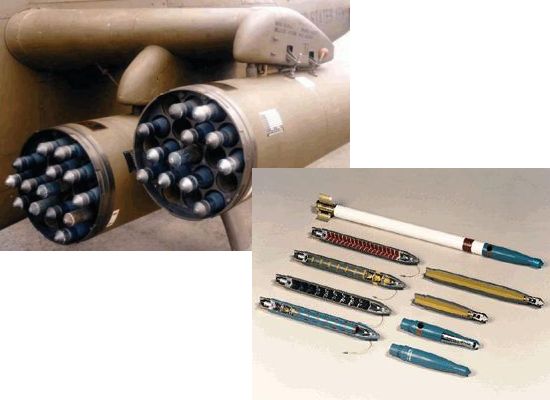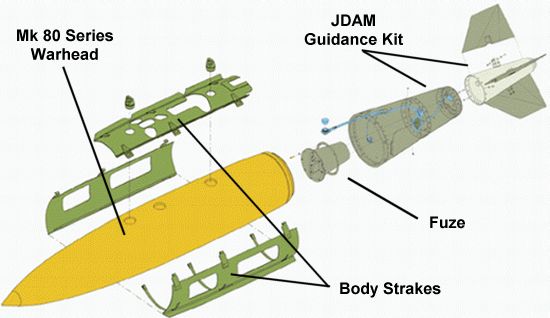|
||||||||||
|
|
||||||||||
|
||||||||||
|
|
||||||||||
Let's first start by defining a bomb, since the bomb was the very first type of weapon to be carried aboard aircraft. A bomb is basically nothing more than a warhead, or an explosive charge, wrapped inside an aerodynamic shell to give it stability as it falls towards a target. A bomb is a purely ballistic weapon, meaning that the only force that acts upon it after it is released from an aircraft is gravity. A bomb has no propulsion system, so the weapon can only travel thanks to its initial momentum and the acceleration of gravity. A bomb also has no form of guidance and will fall wherever its momentum takes it. It is for this reason that unguided bombs are often referred to as "dumb" bombs.

A number of different types of dumb bombs have been developed from World War I until today, and they are typically classified by their weight. A common type is the Mk 80 series developed originally by the US Navy and now also used by the USAF as well as many American allies. The Mk 80 family includes the Mk 81, weighing 250 lb (113 kg), the Mk 82, weighing 500 lb (227 kg), the Mk 83, weighing 1,000 lb (454 kg), and the Mk 84, weighing 2,000 lb (907 kg). In the US munitions designation system, unguided bombs like these are typically denoted by the term BLU for Live Bomb Unit. For example, the Mk 82 and 83, with minor changes, are also known as the BLU-111 and BLU-110 while a close relative of the Mk 84 is the BLU-109. Other nations have also developed their own equivalents to the Mk 80 family, such as the United Kingdom and Russia that use 250 kg and 500 kg unguided bombs.
If an unguided warhead is attached to some type of propulsion system, most often a solid rocket motor, the result is a rocket. A rocket has no form of guidance and remains a "dumb" weapon. However, the rocket has a means of propulsion that allows it to travel farther and faster than a bomb. Unguided rockets are also commonly used weapons around the world, and most nations have developed rocket pods to carry different types of rockets aboard aircraft.

Rockets are typically classified by the maximum diameter of the body tube. A particularly common type in the US military is the 2.75-inch (70-mm) rocket, also known as the Hydra 70. The US military also designates rockets with the term RLU for Live Rocket Unit, or RBU for Rocket and Launcher Unit. These rockets are often carried on attack helicopters like the AH-64 Apache and AH-1 Cobra. Larger types of rockets have also been frequently used on both helicopters and fixed-wing aircraft. Among these are the 5-inch (127-mm) Zuni rocket developed by the US while Russian attack helicopters like the Mi-24 often carry 57-mm, 80-mm, 160-mm, 210-mm, or 240-mm rockets. The Su-17 attack fighter has even been known to carry rockets up to 370-mm (14.5-in) in diameter.
If we take this unguided rocket and now add a guidance system, the result is a missile. A missile contains all three of the elements we have discussed--a warhead, a propulsion system, and some form of guidance. The various types of guidance that are used on missiles were discussed in detail in a previous article. A guidance system mates a sensor or seeker that detects a target to a computer autopilot that commands a control system to steer towards that target. The most common types of seekers or sensors used today include infrared, radar, lasers, inertial, and GPS. It is the use of these guidance systems that turns a "dumb" weapon into a "smart" weapon.

Missiles are usually classified according to their mission, such as air-to-air missiles designed to engage enemy aircraft or air-to-ground missiles designed to attack targets on the surface. The US, for example, designates missiles with names like AIM for Air Intercept Missile and AGM for Air Surface-attack Missile. This mission largely dictates the design of a missile, from its seeker to its warhead to its propulsion to its control system. Air-to-air missiles, like the American AIM-9 Sidewinder or Russian R-77 'Adder,' are usually small and light since they carry small warheads to attack lightly armored targets. However, these targets are often very fast and maneuverable, so the missile requires a very sensitive seeker to track that target, a powerful rocket or ramjet engine to accelerate to high speeds, and a very responsive control system for rapid maneuvers. Air-to-ground missiles, like the AGM-84 Harpoon or European Storm Shadow, are generally much bigger and heavier to carry a large warhead needed to attack more fortified targets. Since these targets are often fixed or slow moving, however, the seeker need not be as sensitive nor the control system as responsive, and the propulsion system usually cruises at relatively slow velocities below the speed of sound.
The other classes of bomb you mention are variations of the types we have already described. A cluster bomb is essentially nothing more than an outer casing for several smaller weapons, or submunitions, contained inside. The US denotes these weapons with the designation CBU for Cluster Bomb Unit, and common examples include the CBU-78 Gator that dispenses mines and the CBU-97 Sensor Fuzed Weapon that dispenses anti-tank projectiles. The granddaddy of them all was the Mk 20 Rockeye, and virtually all cluster bombs in the US inventory use the same outer casing as the Rockeye. This casing is designed to break open over the target area and scatter a series of submunitions to detonate over individual targets.

This casing is unguided, so cluster bombs are typically considered to be "dumb" weapons. However, the submunitions these weapons dispense have become increasingly sophisticated in recent years and may feature propulsion or guidance systems of their own. Among the submunitions carried by cluster bombs are anti-tank weapons, anti-personnel mines, fuel-air explosives, various types of bomblets, and even chemical weapons. Mines and chemical weapons are now largely outlawed by international agreement. Bomblets too often prove unreliable and fail to detonate, leaving unexploded ordnance (UXO) that endangers personnel and civilians long after a conflict has ended. Because of these concerns, cluster weapons are becoming less popular and may be phased out in the future.
A guided bomb, also known as a GBU for Guided Bomb Unit, is an unguided warhead that has a guidance system attached to it. This guidance unit turns the "dumb" warhead into a "smart" bomb, though it still lacks a propulsion system. The most well known guided bombs include laser-guided bombs and GPS-guided bombs. Laser-guided bombs were first developed during the Vietnam War as a method of making more accurate attacks against targets difficult to hit with conventional bombs.

A laser-guided bomb consists of a dumb bomb, like one of the Mk 80 family, with a laser seeker system attached to the nose. Control fins are also added to the nose and tail to give the bomb the ability to maneuver. The seeker makes it possible for the bomb to lock onto a specific target while the control system adjusts the bomb's course and steers it towards that target. Examples of laser-guided bombs include the GBU-12, GBU-16, and GBU-10 shown above. Each of these weapons features a guidance unit and a wing unit attached to the Mk 82 500-lb warhead, Mk 83 1,000-lb warhead, and Mk 84 2,000-lb warhead, respectively.
More recently, the US has developed a new class of guided bombs that uses the Global Positioning System (GPS) to guide to a particular target. Known as Joint Direct Attack Munitions, or JDAM, this series of bombs also makes use of an unguided warhead of the Mk 80 family but adds a guidance unit for improved precision. The JDAM kit consists of a tail unit that is attached to the Mk 80 warhead. This tail unit carries a GPS receiver and processor allowing the weapon to compute its location relative to the coordinates of a pre-programmed target. The guidance system then adjusts the moveable tail fins to control the weapon's trajectory as it falls to the target. Examples of the JDAM family include the GBU-38, based on the Mk 82 500-lb warhead, GBU-32, based on the Mk 83 1,000-lb warhead, and GBU-31, based on the Mk 84 2,000-lb warhead.

In summary, what separates a bomb from a rocket from a missile is whether or not the weapon has a propulsion system of some kind or some form of guidance allowing it to steer towards a particular target. Nevertheless, there remain a few exceptions to the rules we have described. Consider, for example, the Joint Standoff Weapon (JSOW) developed by the United States. JSOW is classified as a missile and is officially designated as AGM-154. However, JSOW is a glide weapon that deploys wings and coasts to its target. Even though the weapon is guided, it has no propulsion system of its own.

According to the definitions described above, JSOW would be best classified as a guided bomb. The weapon was probably designated as a missile since it was originally planned to develop powered variants equipped with a solid rocket motor or jet engine to improve range. Even though these powered versions have never entered service, they would have been considered missiles.
Another interesting exception is new versions of the venerable 2.75-in rocket. Although rockets are cheap and can deliver impressive firepower, they have traditionally suffered from poor accuracy. Pilots are often forced to fire the entire contents of a rocket pod to blanket a large area even though they may only be trying to attack one small target in that area. Both the US Army and Navy have investigated small, low-cost guidance units to improve the accuracy of these weapons and allow one rocket to do the job an entire volley would do in the past. These efforts, known as the Advanced Precision Kill Weapon System (APKWS) and Low-cost Guided Imaging Rocket (LOGIR), would turn today's unguided rockets into guided missiles, much like laser seekers and JDAM kits turned dumb bombs into smart bombs.

Despite this addition of a guidance system, however, both weapons are still officially classified as rockets. This
decision was probably made because the weapons are viewed more as an incremental improvement to existing rockets
rather than as new weapons.
- answer by Jeff Scott, 16 January 2005
Related Topics:
Read More Articles:


|
Aircraft | Design | Ask Us | Shop | Search |

|
|
| About Us | Contact Us | Copyright © 1997- | |||
|
|
|||